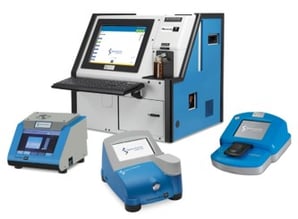How can on-site oil analysis benefit municipal fleets? Our expert, Dan Walsh, illustrates how on-site oil analysis programs can positively impact municipal fleets.
Why On-site Oil Analysis?
A municipal or a city fleet generally has many sets of the same model, brand or grade of product. For example, you could have passenger buses, construction equipment, bucket trucks, police cars, sanitation vehicles, plows, and all sorts of vehicles used for the normal running of a municipal environment or a city. Each one of those vehicles can have between one to seven separate fluid compartments that all need to be checked, monitored and updated on a regular basis.
For oil lubricated systems, the vast majority of fluids are still consumed by passenger cars and heavy-duty vehicles that are in municipal environments. Oil is consumed by engines, hydraulics, compressors, final drives, transmissions, and pumps. All these types of assets and equipment, rotating machinery and reciprocating machinery are common in fleets. The big concern with fleets is that there are two maintenance approaches typically employed. There are reactive and preventative approaches. The reactive approach is when the system is broken, (e.g., the bus or the truck is broken) and you have to bring it back to the shop and do the repairs. The other approach used is preventive maintenance, where you're changing oils and components on a defined interval. Both of these approaches are used, but the vast majority of best-in-class organizations have switchd to some sort of preventive maintenance. Even if you are farming the work out to an external vendor, they are going to charge you for the preventive work to be performed.
How do fleet managers actually try to lower their costs? Well it's a continuous effort. Nowadays, there's really two approaches. One is to consider investing in newer fleets. The argument is that you can include reliability if you've got newer vehicles on the road. If that's the case, look at your replacement costs over time versus the preventative maintenance costs. You can make that calculation or you can do more efficient preventive maintenance inspections and try and keep that vehicle on the road longer. This is particularly important for the high value assets that take several years to procure, perhaps a certain bus fleet or a particular bucket truck or construction vehicle which take longer than typical fleet cars like police vehicles.
One of the things we should think about is what exactly is a preventative maintenance inspection activity? One of the challenges is how do you lower costs and maintain availability? A preventative maintenance, typically performed on any vehicle in the shop or the garage where the vehicles are housed, involves a number of different activities. The obvious ones would be changing oils, fluids, filters, transmissions and performing coolant checks or replacing transmission systems. You also need to perform a check while the vehicle is in the garage. You need to check transmission mounts, drive shafts, CV joints, braking systems, electrical systems, steering, and suspension. There's a variety of different tasks that are required that are continually being demanded. These tasks, not to mention the cost of the fluids replacement or the parts replacement, can be anywhere from 2 to 15 hours of a trained mechanic's time as well as the time the vehicle is out of service while it's going through that process.
For these reasons, on-site oil analysis is a really great tool for fleet maintainers to get a handle on these preventative maintenance costs. Why? If they're running oil samples as the vehicle comes into the bay, they quickly can get important information about the condition of the equipment, which allows them to extend the drain interval. If the oil doesn't need to be changed, they can reduce the amount of inspection time needed to check those fluids. They also save on oil and filtration costs.
You also help the environment by decreasing your carbon footprint by reducing disposal costs and the overall health of the city. You can also look at the wear side of oil analysis and look at advance warnings for mechanical faults. You can decide, based on the information provided, if the vehicle needs to be repaired before it goes out in the field so you can avoid a costly breakdown or tow charges. You can avoid disruption and last-minute concerns and can plan the repair on your own time. Advance notice is particularly important in this day and age because labor is at a real shortage. You want to maximize the efficiency of your trained mechanics to do the most critical work, and you want to coordinate to have all your parts just in time.

Solution
The MicroLab Series is well-suited to performing these tests in a matter of 10 minutes. The MicroLab is simple to use and produces a detailed oil analysis report with clear, actionable, maintenance recommendations. The MicroLab 43 includes the CoolCheck 2 for measuring coolant, the FDM 6000 for fuel dilution and the FerroCheck 2000 for measuring ferrous wear. This is really the ideal choice for taking care of a municipal fleet.

